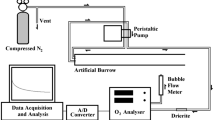Summary
Development of the drinking mechanism from the day of hatching to the 4 week old chick was studied in relation to the growth of the oropharynx and drinking performance. Results indicate that due to scaling effects in the growing oropharynx, physical factors require the development of extra mechanisms. The swallowing mechanism to transport water from the pharynx into the esophagus during the tip up phase is already present in hatchlings, and does not change during ontogeny. The mechanism for water intake during the immersion phase changes considerably. Hatchlings display pecking behavior towards water. Week old chicks protrude the tongue far out, and the total volume ingested is sucked up by capillary action between the tongue, the floor, and the roof of the oropharynx. In 2 and 3 week old chicks the relative distance over which water is sucked up by capillarity decreases, whereas the volume of water pushed caudad by the tongue and bills increases. Laryngeal suction also develops in this period. At the age of 4 weeks chickens use the adult mechanism to drink. Most oropharyngeal elements increase two to three times in length and width during post hatching ontogeny. Due to these increases, water transport by capillarity alone does not suffice in the older age groups; therefore additional mechanisms such as pressure development by closing the bills and laryngeal suction must develop. Relative to the oropharyngeal length most elements grow isometrically. The width of the lingual alae and the larynx width, however, increase with positive allometry, which improves both capillary action as well as the transport of water during the tip up phase when the chicks grow older. The need to develop extra water transport mechanisms during growth due to scaling effects is shown to condition the radiation capacity of avian drinking mechanisms. Nidicolous birds are, however, not constrained by the need to have a properly operating drinking mechanism during the early ontogeny and may therefore have a better chance of developing alternativ drinking mechanisms then nidifugous birds.
Similar content being viewed by others
References
Baumel JJ, King AS, Lucas AM, Breazille JE, Evans HE (eds) (1979) Nomina Anatomica Avium. Academic Press, London
Cracraft J (1988) The major clades of birds. In: Benton M (ed) The phylogeny and classification of Tetrapods, vol I. Amphibians, reptiles, birds. Clarendon Press, Oxford
Gennip EMSJ van (1988) A functional morphological study of the feeding system in pigeons (Columba livia L.). Thesis. Leiden University, Netherlands
Heidweiller J (1989) Post natal development of the neck system in the chickens (Gallus domesticus). Am J Anat 186:258–270
Heidweiller J, Zweers GA (1990) Drinking mechanisms in the zebrafinch and Bengalese finch (Poephila guttata andLonchurastriata). Condor 92:1–28
Heidweiller J, Loon JA van, Zweers GA (1992) Flexibility of the drinking mechanism in adult chickens (Gallus gallus) (Aves). Zoomorphology 111:141–159
Homberger DG (1983) Nonadaptive evolution of avian drinking methods. Am Zool 23:894
Hunt GL, Smith JW (1967) Pecking and initial drinking responses in young domestic fowl. J Comp Physiol Psychol 64:230–236
Huxley JS (1972) Problems of relative growth. Dover Publications, New York
Kooloos J, Zweers GA (1989) Mechanics of drinking in the mallard (Anas platyrhynchos, Anatidae). J Morphol 199:327–347
Mattfeldt T, Mall G (1987) Statistical methods for growth allometric studies. Growth 52:86–102
McLelland J (1979) Digestive system. In: King AS, McLelland J (eds) Form and Function in birds, vol I. Academic Press, London, pp 69–181
McMahon TA (1984) Muscles, reflexes and locomotion. Princeton University Press, Princeton
Sokal RR, Rohlf FC (1981) Biometry. 2nd ed. Freeman, New York
White SS (1970) The larynxof Gallus domesticus. Thesis. University of Liverpool, England
Zweers GA (1982) Drinking of the pigeon (Columba livia). Behaviour 80:274–317
Zweers GA (1991) Pathways and space for evolution of feeding mechanisms in birds. Proc Int Congr Syst Evol Biol IV. Disciorides Press, Portland, pp 21 (in press)
Author information
Authors and Affiliations
Rights and permissions
About this article
Cite this article
Heidweiller, J., Zweers, G.A. Development of drinking mechanisms in the chicken (Gallus gallus) (Aves). Zoomorphology 111, 217–228 (1992). https://doi.org/10.1007/BF01633010
Received:
Issue Date:
DOI: https://doi.org/10.1007/BF01633010




